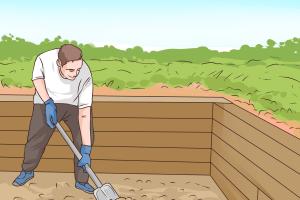Mastering Retaining Walls: A Comprehensive Guide to Building with 4x4 Treated Posts

-
Quick Links:
- Introduction
- Understanding Retaining Walls
- Materials Needed
- Planning Your Retaining Wall
- Step-by-Step Construction Process
- Maintenance Tips for Retaining Walls
- Case Studies and Real-Life Examples
- Conclusion
- FAQs
Introduction
Building a retaining wall can be a rewarding project for homeowners looking to enhance their landscape while managing soil erosion. One of the most popular methods is using 4x4 treated posts, which provide durability and strength. In this comprehensive guide, we'll walk you through the entire process—from understanding the purpose of retaining walls to the step-by-step construction process and maintenance tips.
Understanding Retaining Walls
Retaining walls are structures designed to hold back soil and prevent erosion. They are commonly used in landscaping to create terraces, level out sloped yards, and manage water runoff. Here are some key points to consider:
- Types of Retaining Walls: Gravity walls, cantilever walls, anchored walls, and more.
- Benefits: Prevent soil erosion, improve aesthetics, and create usable space.
- Considerations: Drainage, soil type, wall height, and local regulations.
Materials Needed
Before you begin construction, gather the following materials:
- 4x4 Treated Posts: Essential for the main structure.
- Gravel: For drainage and stability.
- Landscape Fabric: To prevent weeds and soil mixing.
- Concrete Mix: Optional, for additional stability.
- Reinforcement Materials: Such as metal brackets or stakes.
- Tools: Post hole digger, level, saw, hammer, and measuring tape.
Planning Your Retaining Wall
Proper planning is crucial for a successful retaining wall project. Consider the following steps:
1. Assess Your Site
Evaluate the slope and drainage patterns of your yard. This will help you determine the wall's height and length.
2. Design Your Wall
Create a design that suits your landscape. Consider the wall's height, length, and aesthetic features.
3. Check Local Regulations
Always check local building codes and obtain necessary permits before starting construction.
Step-by-Step Construction Process
Step 1: Prepare the Site
Clear the area of debris, plants, and rocks. Mark the wall's location with stakes and string.
Step 2: Dig the Trenches
Use a post hole digger to create holes for the 4x4 posts. The depth should be at least 1/3 of the post height.
Step 3: Install Drainage
Place gravel at the bottom of the trench to facilitate drainage. Consider adding perforated pipe if necessary.
Step 4: Set the Posts
Place the 4x4 treated posts in the holes, ensuring they are plumb and level. Fill the holes with gravel or concrete mix for support.
Step 5: Add Landscape Fabric
Place landscape fabric against the back of the wall to prevent soil and weeds from penetrating through.
Step 6: Backfill
Carefully backfill the area behind the wall with soil, compacting it as you go to ensure stability.
Step 7: Finishing Touches
Consider adding decorative features such as stones or plants to enhance the wall's appearance.
Maintenance Tips for Retaining Walls
To ensure the longevity of your retaining wall, follow these maintenance tips:
- Regularly inspect for signs of wear or soil erosion.
- Keep drainage areas clear of debris.
- Repair any cracks or shifts in the wall promptly.
- Consider re-staining or treating the wood every few years.
Case Studies and Real-Life Examples
Let's look at a few case studies to illustrate the effectiveness of 4x4 treated post retaining walls:
Case Study 1: A Sloped Backyard
A homeowner in Oregon successfully built a 3-foot tall retaining wall using 4x4 treated posts to prevent soil erosion in their backyard. The wall not only stabilized the slope but also created a beautiful garden area.
Case Study 2: Urban Landscaping
In a crowded urban setting, a family constructed a series of terraced retaining walls using treated posts to maximize their small yard. This project increased their usable space and enhanced their outdoor aesthetics.
Conclusion
Building a retaining wall with 4x4 treated posts is a manageable project for those with basic DIY skills. By following the steps outlined in this guide, you can create a durable and attractive structure that not only enhances your landscape but also addresses soil erosion concerns.
FAQs
1. How deep should I set my 4x4 treated posts?
Posts should be set at least 1/3 of their height into the ground for stability.
2. Can I build a retaining wall without a permit?
This depends on local regulations. Always check with your local building authority.
3. What is the best drainage solution for a retaining wall?
Using gravel and possibly a perforated drainage pipe is typically the best solution.
4. How long do treated posts last?
4x4 treated posts can last 15-20 years, depending on environmental conditions.
5. Can I paint or stain my retaining wall?
Yes, you can paint or stain your retaining wall to enhance its appearance and protect the wood.
6. What's the best way to maintain a wooden retaining wall?
Regular inspections, clearing drainage areas, and treating the wood are essential for maintenance.
7. Are there alternatives to treated wood for retaining walls?
Yes, alternatives include concrete blocks, stone, and composite materials.
8. How can I prevent weeds from growing through my retaining wall?
Using landscape fabric is effective in preventing weeds.
9. What tools do I need to build a retaining wall?
You will need a post hole digger, level, saw, hammer, and measuring tape at a minimum.
10. Can I add a garden on top of my retaining wall?
Yes, adding a garden can enhance the aesthetics, but ensure proper drainage and support.
Random Reads
- Unlocking secure boot
- Increase dedicated video ram intel graphics
- Insert background image word
- How to open python file
- How to open port firewall
- How to open rar files mac os x
- How to make a powerpoint template
- How to print on an envelope using microsoft word
- How to print screen hp
- No guitar hero controller use ps2 controller